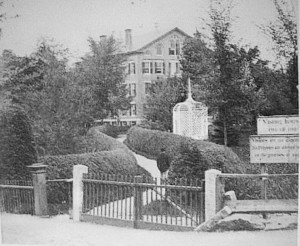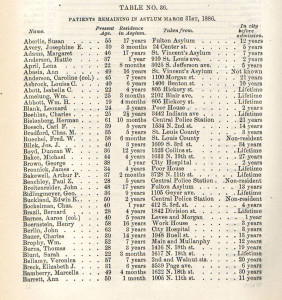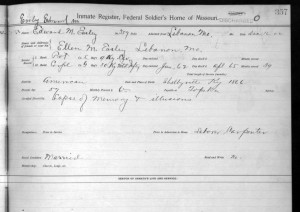Until much later, inspections of the Canton Asylum for Insane Indians tended to focus on its physical assets rather than the patients (see last two posts). When Inspector Breid made his detailed comments about the state of the asylum’s floors in 1912, Superintendent Hummer’s reply to his concerns was just as detailed.
Tag Archives: Dr. Harry Hummer
New Year, New Problems
New years may imply fresh starts, but for the superintendent of the Canton Asylum for Insane Indians, a new year often meant the same old–or brand new–problems to deal with. The asylum was inspected by Supervisor Jacob Breid in January, 1912. A new sewer had just been completed, but did not work; water was not flowing correctly through one of the manholes about 1,500 feet away from the buildings. Continue reading
Importance of Asylum Gardens
Asylum gardens provided occupational therapy of a sort for patients who were physically able to work in them. Some patients truly enjoyed working in a small flower garden perhaps, or even an hour or two in a vegetable garden.
However, because some superintendents reported having to “force” patients to work outside, this so-called therapy obviously did not appeal to everyone. Continue reading
And More Cereal
Cold, flaked cereals were not a part of traditional Native American diets, but many Native Americans on reservations doubtlessly ate them. So did the patients at the Canton Asylum for Insane Indians.
Both Sylvester Graham and John Harvey Kellogg (see last post) considered grains part of a healthy diet, and created products that reflected their beliefs. Whether or not Superintendent Harry Hummer also believed this or simply had to take what was issued to him through the Indian Office, he did serve this breakfast food at the asylum. Continue reading
Water Closets
Ordinary homes during the late 1800s and well into the 1900s had few conveniences (see last post); unlike homes today, a dedicated bathroom was a luxury. A largely rural population typically used an outhouse, which could be indifferently built at worst and an uncomfortable distance from the home at best. Continue reading
How to Help

Occupational Therapy, Toy Making in WWI-Era Psychiatric Hospital, courtesy Otis Historical Archives, National Museum of Health and Medicine
Dr. Harry Hummer, superintendent of the Canton Asylum for Insane Indians, was not inclined to an active, hands-on approach to helping his patients overcome mental illness. In addition to his own weakness in this area, he may have found it nearly impossible to apply his book knowledge to real-life situations at the asylum. Continue reading
Keeping Up
Like most people, Dr. Harry Hummer, superintendent of the Canton Asylum for Insane Indians, had a number of contradictory traits. Though he was accused of poor record-keeping on his patients and of a failure to institute any kind of mental health plan for them, he was clearly interested in maintaining expertise in his field. Continue reading
Paperwork
Running an insane asylum involved a great deal of administrative work, and it is no wonder that some records were not as meticulous as inspectors and latter-day researchers would have liked.
Dr. Harry Hummer, superintendent of the Canton Asylum for Insane Indians, was often accused of poor-record keeping. However, not all of his records were badly kept; the problem lay in where he chose to put his efforts. A February, 1927 journal voucher lists 30 patients along with small sums spent on their behalf. These sums ranged from a few dollars to fifteen cents, yet Dr. Hummer kept track of them for reimbursement purposes.
Conversely, he spent almost no time updating patient medical records during the asylum’s later years; he left that task to his attendants who often jotted repetitive, meaningless updates that were useless for diagnostic purposes. Perhaps Dr. Hummer put his energy only into those tasks he thought would benefit himself and contribute to the efficiency of the asylum.
Many asylums have not retained all their patient records (or have deliberately destroyed them), so Canton Asylum’s incomplete patient records does not present an unusual situation. One inadvertent benefit to Hummer’s attention to detail in certain areas is that it is at least possible to cull patient names from these types of documents.
By going through vouchers and reports, researchers can fill in gaps that might exist in the records they would prefer to have, or uncover tidbits of information that present a clearer picture of their subject matter. For instance, a payroll list from June 1923 shows that Dr. Hummer’s father, Levi, and his son, Harry Hummer, Jr. were employed at the asylum; additionally, a separate letter to the Indian Office that same month shows that Dr. Hummer’s other son, Francis, acted as an escort for patients coming to the asylum from Taos, New Mexico. It would certainly be interesting to speculate or do further research on the dynamics of this family employment.
Reports, Reports
With perhaps a very rare exception, all insane asylums were inspected on a reasonably regular basis, and inspectors visited the Canton Asylum for Insane Indians a number of times. Visits were usually routine, though the asylum received a number of special inspections brought on by complaints or allegations of misconduct that reached the Indian Office. Continue reading
A Difficult Life for All
Though patients undoubtedly had wretched experiences at most asylums, the life of an attendant was also difficult. Even in the first decades of the twentieth century, it was usual for attendants and other staff (including physicians) to reside at the asylum where they worked. Continue reading










